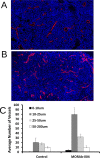Targeting endosialin/CD248 through antibody-mediated internalization results in impaired pericyte maturation and dysfunctional tumor microvasculature
- PMID: 26327620
- PMCID: PMC4694842
- DOI: 10.18632/oncotarget.4559
Targeting endosialin/CD248 through antibody-mediated internalization results in impaired pericyte maturation and dysfunctional tumor microvasculature
Abstract
Over-expression of endosialin/CD248 (herein referred to as CD248) has been associated with increased tumor microvasculature in various tissue origins which makes it an attractive anti-angiogenic target. In an effort to target CD248, we have generated a human CD248 knock-in mouse line and MORAb-004, the humanized version of the mouse anti-human CD248 antibody Fb5. Here, we report that MORAb-004 treatment significantly impacted syngeneic tumor growth and tumor metastasis in the human CD248 knock-in mice. In comparison with untreated tumors, MORAb-004 treated tumors displayed overall shortened and distorted blood vessels. Immunofluorescent staining of tumor sections revealed drastically more small and dysfunctional vessels in the treated tumors. The CD248 levels on cell surfaces of neovasculature pericytes were significantly reduced due to its internalization. This reduction of CD248 was also accompanied by reduced α-SMA expression, depolarization of pericytes and endothelium, and ultimately dysfunctional microvessels. These results suggest that MORAb-004 reduced CD248 on pericytes, impaired tumor microvasculature maturation and ultimately suppressed tumor development.
Keywords: CD248; MORAb-004; endosialin; tumor microvasculature; α-SMA.
Conflict of interest statement
There are no potential conflicts of interest disclosed by the authors.
Figures







References
-
- Weis SM, Cheresh DA. Tumor angiogenesis: molecular pathways and therapeutic targets. Nat Med. 2011;17:1359–1370. - PubMed
-
- Valdez Y, Maia M, Conway EM. CD248: reviewing its role in health and disease. Curr Drug Targets. 2012;13:432–439. - PubMed
-
- Holmes K, Roberts OL, Thomas AM, Cross MJ. Vascular endothelial growth factor receptor-2: structure, function, intracellular signalling and therapeutic inhibition. Cell Signal. 2007;19:2003–2012. - PubMed
-
- Ichihara E, Kiura K, Tanimoto M. Targeting angiogenesis in cancer therapy. Acta Med Okayama. 2011;65:353–362. - PubMed
MeSH terms
Substances
LinkOut - more resources
Full Text Sources
Other Literature Sources
Molecular Biology Databases
Miscellaneous

